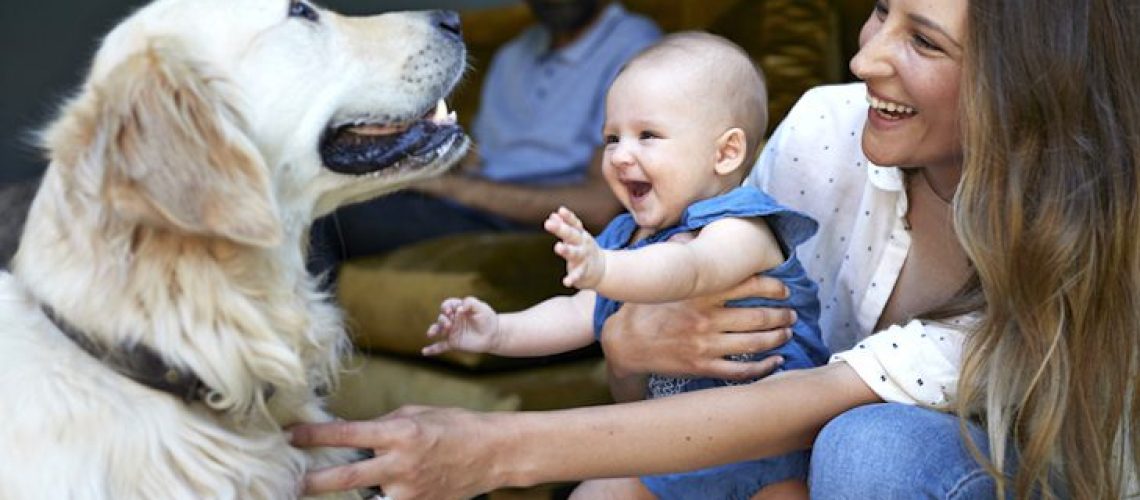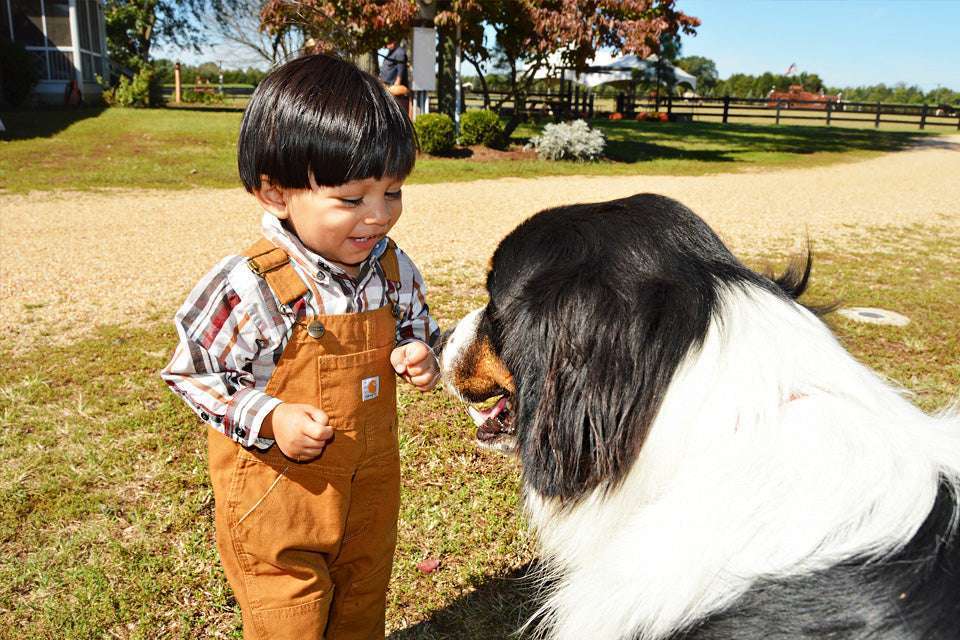Introducing puppies to babies: A guide for a harmonious bond.
Key Takeaways:
- Supervision is crucial during puppy and baby introductions to ensure the safety of both the child and the dog.
- Gradual introductions are recommended to allow the puppy and baby to become familiar with each other's presence.
- Positive reinforcement should be used to reward good behavior from both the puppy and the baby during interactions.
- Teaching a puppy basic obedience commands, such as "sit" and "stay," can help establish boundaries and prevent any potential accidents or conflicts with a baby.
- It is important to monitor and manage the energy levels of both the puppy and the baby to prevent overwhelming or overstimulating either party during their interactions.
The Importance of Introducing Puppies and Babies Safely
Introducing puppies and babies safely is crucial to ensure a positive and harmonious relationship between them. Both puppies and babies are curious, vulnerable, and still learning about the world around them. By introducing them in a controlled and supervised manner, we can help them build trust, develop social skills, and prevent any potential accidents or negative experiences.
When puppies and babies interact positively from an early age, it can have long-lasting benefits for both. Puppies can learn to be gentle and patient around babies, while babies can develop empathy, compassion, and a love for animals. This early introduction also helps establish a foundation for a strong bond between the two as they grow older.
Benefits of Introducing Puppies and Babies Safely:
- Promotes positive socialization skills in both puppies and babies
- Builds trust between the puppy and baby
- Prevents potential accidents or negative experiences
- Fosters a strong bond between the puppy and baby
- Encourages empathy, compassion, and love for animals in babies
Tips for Safe Introduction:
- Always supervise interactions between the puppy and baby
- Create a calm environment with minimal distractions
- Start with short interactions gradually increasing their duration over time
- Reward positive behaviors from both the puppy and baby
- Allow the puppy to approach the baby at its own pace
By following these guidelines for safe introductions between puppies and babies, we can ensure that their interactions are enjoyable, safe, and beneficial for both parties involved.
Common Concerns When Introducing a Puppy to a Baby
Puppy's Behavior:
One common concern when introducing a puppy to a baby is how the puppy will behave around the baby. Puppies are naturally curious and may want to investigate the new addition to the family. However, it is important to monitor their behavior closely to ensure they do not become too rough or aggressive with the baby. It is also important to teach the puppy appropriate behaviors, such as not jumping on or biting the baby.
Baby's Safety:
Another concern is ensuring the safety of the baby when introducing a puppy. Puppies have sharp teeth and claws that can accidentally harm a baby if not properly supervised. It is crucial to create a safe environment for both the puppy and the baby by setting boundaries and providing separate spaces when necessary.
Tips for addressing these concerns:
1. Gradual Introduction: Start by allowing brief supervised interactions between the puppy and baby in controlled environments.
2. Positive Reinforcement: Reward both the puppy and baby for calm and gentle behavior during interactions.
3. Supervision: Always supervise interactions between puppies and babies, even if they seem comfortable with each other.
4. Separate Spaces: Create designated areas for both the puppy and baby where they can have their own space when needed.
5. Training: Teach your puppy basic obedience commands such as "sit" and "stay" to help establish control during interactions.
Overall, addressing common concerns when introducing a puppy to a baby requires careful supervision, gradual introductions, positive reinforcement, and creating safe spaces for both parties involved.
Preparing Your Home for a New Puppy or Baby
Puppy-proofing Your Home:
Before bringing home a new puppy or welcoming a baby into your home, it is essential to make sure your living space is safe for them. Puppy-proofing involves removing any potential hazards such as toxic plants, small objects that can be swallowed, and securing loose cords or wires. Baby-proofing includes installing safety gates, covering electrical outlets, and securing furniture to prevent accidents.
Creating Separate Spaces:
To ensure the comfort and safety of both the puppy and baby, it is important to create separate spaces within your home. This allows each of them to have their own designated areas where they can retreat to when needed. For the puppy, provide a crate or a specific room with their bed, toys, and water bowl. For the baby, set up a nursery with a crib, changing table, and baby essentials.
Tips for preparing your home:
1. Remove Hazards: Identify potential hazards in your home such as toxic plants or choking hazards and remove them.
2. Secure Loose Items: Secure loose cords or wires that may tempt a curious puppy or pose a danger to a crawling baby.
3. Install Safety Gates: Use safety gates to block off certain areas of the house where the puppy or baby should not have access.
4. Anchor Furniture: Secure heavy furniture like bookshelves or TV stands to prevent tipping over when the puppy or baby starts exploring.
5. Create Comfortable Spaces: Ensure both the puppy and baby have comfortable spaces with their essential items easily accessible.
By taking these steps to prepare your home for a new puppy or baby, you can create a safe environment that promotes their well-being and minimizes potential risks.
Gentle Ways to Help a Puppy and Baby Get Used to Each Other
Introducing Scent
One gentle way to help a puppy and baby get used to each other is by introducing their scents before they have direct contact. This can be done by allowing the puppy to sniff a blanket or piece of clothing that belongs to the baby, and vice versa. By familiarizing themselves with each other's scent, both the puppy and baby can start to feel more comfortable in each other's presence.
Supervised Interactions
It is important to always supervise interactions between a puppy and a baby. This ensures the safety of both parties and allows for immediate intervention if necessary. Start with short, controlled interactions where both the puppy and baby are calm. Gradually increase the duration of these interactions as they become more comfortable with each other.
Positive Reinforcement
Using positive reinforcement techniques can help create positive associations between the puppy and baby. For example, when the puppy behaves calmly around the baby, reward them with treats or praise. This helps reinforce good behavior and encourages a positive bond between them.
Rules and Guidelines for the First Interactions Between Puppies and Babies
No Rough Play
It is important to establish rules from the beginning that there should be no rough play between puppies and babies. Puppies may naturally want to jump or nip during play, but this behavior can be dangerous for babies. Teach the puppy appropriate play behaviors, such as gentle chewing on toys instead of hands or feet.
Teaching Boundaries
Set clear boundaries for both the puppy and baby during their first interactions. For example, designate certain areas as off-limits for the puppy, such as the baby's crib or play area. This helps establish a safe space for the baby and prevents any potential accidents or conflicts.
Gradual Introductions
Gradually introduce the puppy and baby to each other in controlled environments. Start with short, supervised interactions and gradually increase the duration and frequency as they become more comfortable with each other. This gradual approach helps prevent overwhelming either the puppy or baby and allows them to build trust at their own pace.
Ensuring Safety during the First Interactions Between Puppies and Babies
Physical Separation
When the puppy and baby are not directly interacting, it is important to have physical separation between them. Use baby gates or playpens to create separate areas for each of them. This prevents any accidental contact or unwanted interactions when supervision may be momentarily distracted.
No Unsupervised Contact
Never leave a puppy and baby alone together without supervision. Even if they have had positive interactions in the past, it is crucial to always have someone present who can intervene if needed. Accidents can happen quickly, so it is better to err on the side of caution.
Safe Handling Techniques
Teach both adults and older children proper handling techniques when it comes to interacting with puppies and babies. This includes gentle petting, avoiding pulling on ears or tails, and supporting the puppy's body properly when holding them. By ensuring safe handling practices, you reduce the risk of unintentional harm to either party.
Signs to Determine if a Puppy is Comfortable Around a Baby
Relaxed Body Language
A relaxed body language is a good indicator that a puppy is comfortable around a baby. Look for loose muscles, wagging tail, and ears in a neutral position. If the puppy appears tense or exhibits signs of stress, such as growling or hiding, it may be a sign that they are not comfortable and need more time to adjust.
Positive Interactions
Observe the puppy's behavior during interactions with the baby. Positive signs include gentle sniffing, wagging tail, and playfulness. If the puppy initiates positive interactions or seeks out the baby's company willingly, it indicates that they are comfortable being around them.
Reliable Recall
A reliable recall is an important sign that a puppy is comfortable around a baby. If the puppy responds promptly to their name or a recall command even when near the baby, it shows that they feel secure and trust their environment. This is a positive indication of their comfort level.
Increasing Interaction between a Puppy and a Baby as They Grow Older
Supervised Playtime
As both the puppy and baby grow older, supervised playtime can be increased. Allow them to interact in safe environments under close supervision. Encourage gentle play between them while ensuring boundaries are still respected.
Incorporating Joint Activities
Find activities that can be enjoyed by both the puppy and baby as they grow older. This could include short walks together or interactive games where they can participate together with adult supervision. These joint activities help strengthen their bond and create positive shared experiences.
Building Trust through Routine
Establishing routines can help build trust between the puppy and baby. Consistency in daily activities such as feeding times, playtimes, and nap times creates predictability for both parties. This predictability helps foster trust and comfort in each other's presence.
Tips and Resources for Creating a Positive Bond between a Puppy and a Baby
Professional Training
Consider enrolling the puppy in professional training classes to ensure they learn appropriate behaviors around babies. Professional trainers can provide guidance on how to create a positive bond and address any specific concerns or challenges.
Books and Online Resources
There are numerous books and online resources available that provide valuable information on introducing puppies to babies and fostering positive relationships between them. These resources offer tips, advice, and techniques that can help navigate the process.
Consulting with Veterinarian
Consult with your veterinarian for personalized advice and recommendations based on your specific puppy's needs. They can provide guidance on vaccinations, health considerations, and any potential risks associated with interactions between puppies and babies.

















